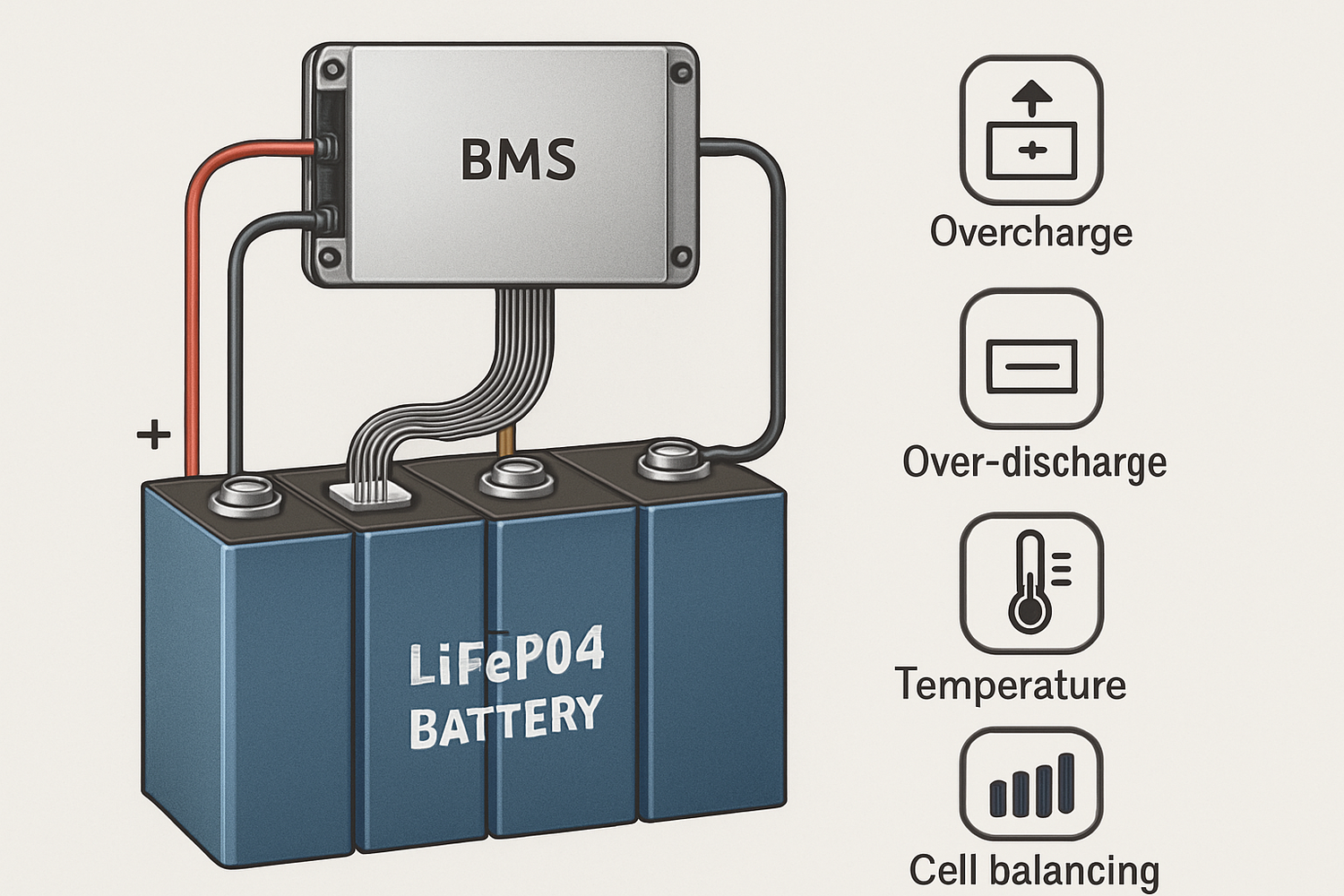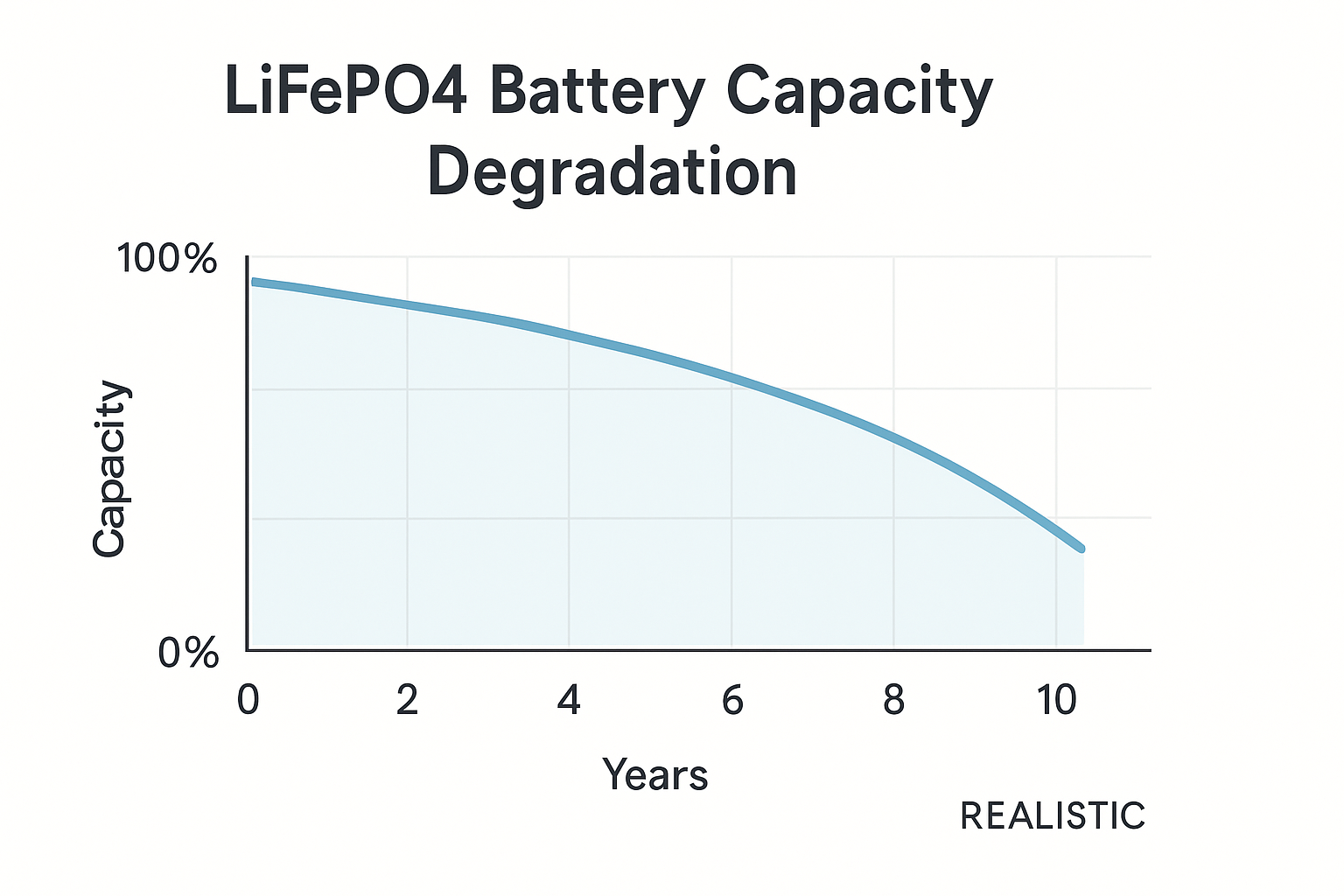Lithium iron phosphate (LiFePO4) batteries are central to modern energy storage solutions, known for their safety and longevity. Yet, significant confusion exists around how long they actually last. Many discussions are filled with myths and marketing claims that don't align with the underlying science. This article separates common misconceptions from engineering reality to provide a clear picture of LiFePO4 battery degradation and what truly defines its operational life.
The Foundation of Longevity: Understanding LiFePO4 Degradation
A battery's lifespan isn't a fixed date but a gradual process of performance decline. Understanding the factors that cause this degradation is the first step toward maximizing the value of your energy storage investment. The two primary metrics are cycle life and calendar life, both of which are influenced by how the battery is used.
What is Cycle Life, Really?
Cycle life isn't an abrupt endpoint where a battery stops working. It refers to the number of charge and discharge cycles a battery can endure before its capacity drops to a certain percentage of its initial rating, typically 80%. This capacity fade is a slow decline, not a sudden failure. A battery rated for 5,000 cycles at 80% Depth of Discharge (DoD) will still function after cycle 5,001, but with slightly less than 80% of its original capacity.
Key Stress Factors: Temperature, DoD, and C-Rate
Several operational variables directly impact the internal chemistry of a LiFePO4 battery, accelerating its degradation. The three most significant are temperature, Depth of Discharge (DoD), and C-rate (the speed of charge or discharge). High temperatures, deep discharges, and aggressive C-rates all place mechanical and chemical stress on the battery's components, leading to a faster loss of usable capacity. According to the International Energy Agency (IEA), managing these factors is crucial for the large-scale deployment of reliable battery storage.
Myth #1: 'A LiFePO4 Battery Lasts for 10,000 Cycles, No Matter What.'
This is one of the most pervasive myths. While LiFePO4 batteries can achieve very high cycle counts, this figure is highly dependent on operating conditions. The advertised maximum cycle life is often based on ideal, laboratory-controlled scenarios that don't reflect real-world use.
The Reality of Depth of Discharge (DoD)
Depth of Discharge has a profound effect on cycle life. A shallower discharge puts less strain on the battery. For instance, a battery cycled to only 50% DoD will last significantly more cycles than one consistently discharged to 100%. This relationship is not linear; reducing the DoD from 100% to 80% can more than double the expected cycle life.
| Depth of Discharge (DoD) | Estimated Cycle Life |
|---|---|
| 100% | 2,000 - 3,000 |
| 80% | 4,000 - 6,000 |
| 50% | 8,000 - 12,000 |
The Impact of C-Rate
The C-rate measures how fast a battery is charged or discharged relative to its capacity. A 1C rate on a 100Ah battery means drawing 100 amps. High C-rates generate more internal heat and accelerate electrode degradation. Research shows that operating at lower C-rates, such as 0.25C to 0.5C, can dramatically reduce mechanical stress and heat, potentially doubling the battery's lifespan. As detailed in the Ultimate Reference for Solar Storage Performance, matching your C-rate to your application's demands is a key part of effective system design.
Myth #2: 'You Must Fully Discharge the Battery Periodically.'
This advice stems from older battery technologies and is not applicable to LiFePO4 chemistry. In fact, following this myth will actively shorten your battery's life.
The 'Memory Effect' Misconception
The 'memory effect' is a phenomenon associated with Nickel-Cadmium (NiCd) batteries, where they would 'remember' a partial discharge point and lose capacity if not fully cycled. LiFePO4 batteries do not suffer from this issue. Their chemistry is fundamentally different and does not require periodic deep discharges to maintain capacity.
Why Partial States of Charge Are Better
LiFePO4 batteries are happiest when operating in a partial state of charge, avoiding the extremes of being fully charged or fully empty. Consistently keeping the state of charge (SoC) between 20% and 80% minimizes stress on the cells and can significantly extend their operational life. Deep discharges should be avoided whenever possible.
Myth #3: 'All LiFePO4 Batteries Are Created Equal.'
The internal components and manufacturing quality of a LiFePO4 battery are critical determinants of its longevity and performance. Two batteries with the same capacity rating can have vastly different lifespans.
The Importance of Cell Quality and Grade
LiFePO4 cells are often sorted into grades (e.g., Grade A, Grade B) based on their performance characteristics and internal resistance. Grade A cells are of higher quality, offering better consistency, lower degradation rates, and a longer service life. Lower-grade cells may be cheaper initially but often degrade faster, leading to a lower return on investment.
The Role of the Battery Management System (BMS)
The Battery Management System (BMS) is the brain of the battery pack. It is a crucial component that protects the cells from damaging conditions. A high-quality BMS will prevent over-charging, over-discharging, and exposure to extreme temperatures. It also performs cell balancing, ensuring all cells in the pack are at an equal voltage, which is vital for both safety and longevity. A poor or improperly configured BMS is a common cause of premature battery failure.
Myth #4: 'Temperature Doesn't Matter Much for LiFePO4.'
While LiFePO4 chemistry is more thermally stable than other lithium-ion variants, temperature remains one of the most critical factors influencing its lifespan.
The Engineering Truth about Thermal Management
LiFePO4 batteries have an ideal operating temperature range, typically between 15°C and 35°C (59°F to 95°F). Operating consistently at high temperatures (above 45°C or 113°F) significantly accelerates chemical degradation inside the cells, leading to permanent capacity loss. The U.S. Department of Energy emphasizes that effective thermal management is essential for battery life and performance in all applications, from electric vehicles to grid storage.
Cold Weather Performance vs. Longevity
Low temperatures also present challenges. While discharging in the cold leads to a temporary reduction in available capacity, charging below freezing (0°C or 32°F) can cause irreversible damage. This is due to a phenomenon called lithium plating, which can permanently reduce capacity and create internal short circuits. A quality BMS will prevent charging when the cell temperature is too low.
Myth #5: 'The Stated Lifespan is a Guarantee of Usable Life.'
The lifespan figures provided by manufacturers are estimates based on specific conditions. Real-world usable life depends on the application and how the battery's degradation is managed over time.
Capacity Fade vs. End-of-Life
A battery's end-of-life is typically defined as the point when it retains 80% of its original capacity. However, the battery is still usable beyond this point, just with reduced energy storage. For an off-grid home, a 20% loss in capacity might be manageable, while for a critical industrial application, it might necessitate a replacement. The 'usable life' is therefore application-specific.
Real-World Application and System Design
Ultimately, a battery's longevity is tied to the design of the entire energy system. An appropriately sized battery bank, a compatible inverter with correct voltage settings, and proper load management all contribute to a longer life. A well-designed system respects the battery's operational limits, ensuring it is not subjected to excessive C-rates or deep discharges, thereby maximizing its service life.
A Realistic Perspective on Battery Longevity
The lifespan of a LiFePO4 battery is not a single, simple number. It is the result of a complex interplay between cell quality, operational habits, and system design. By moving past the myths and understanding the engineering realities of battery degradation, you can make informed decisions. Proper management of discharge depth, C-rates, and temperature, supported by a high-quality BMS, is the true path to achieving a long and reliable service life from your energy storage system.
Frequently Asked Questions
How long do LiFePO4 batteries last in real-world use?
With proper management, a quality LiFePO4 battery used in a solar storage or off-grid application can realistically last 10 to 15 years. This assumes average cycling that avoids consistent deep discharges and extreme temperatures. The total number of cycles can range from 3,000 to over 8,000 depending heavily on the average Depth of Discharge.
Does leaving a LiFePO4 battery on a charger shorten its life?
No, as long as it is managed by a quality BMS. A proper BMS will stop the charging current once the cells are full, preventing overcharging. Unlike older battery chemistries, there is no need to remove a LiFePO4 battery from its charger once it reaches 100% state of charge.
What is the single biggest factor in LiFePO4 battery degradation?
While several factors contribute, a combination of high temperature and a high state of charge is particularly damaging. Storing a fully charged battery in a hot environment will accelerate capacity loss more than any other single factor. Therefore, keeping the battery cool and, if storing for long periods, at a partial state of charge (around 50%) is highly recommended.





Leave a comment
All comments are moderated before being published.
This site is protected by hCaptcha and the hCaptcha Privacy Policy and Terms of Service apply.